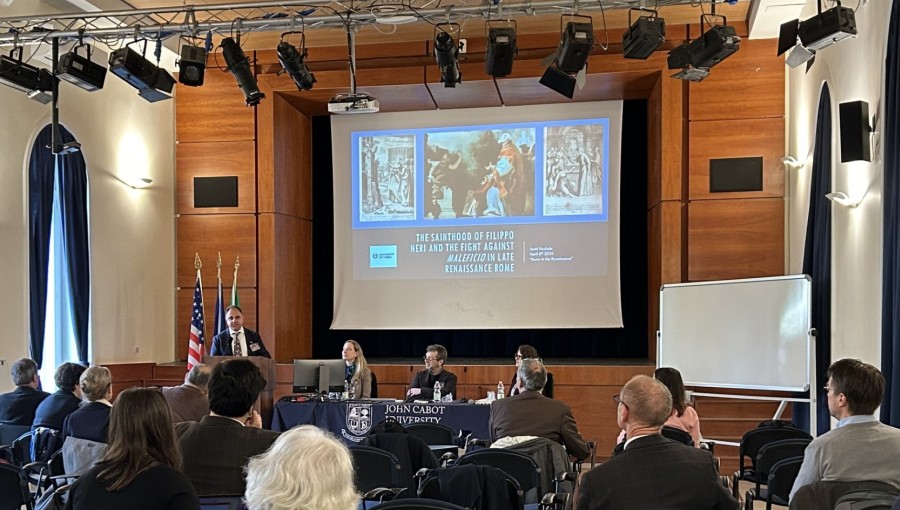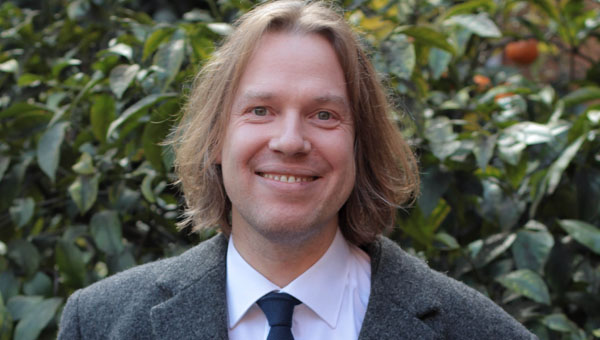Giorgio de Chirico and Philosophy: JCU Welcomes Professor Riccardo Dottori
The JCU Department of History and Humanities welcomed Professor Riccardo Dottori who gave a talk on “Giorgio de Chirico and Philosophy” on November 5, 2019. Philosophy professor Stefan Lorenz Sorgner introduced Professor Dottori and moderated the event.
Professor Dottori is an Emeritus Professor of Philosophy of the University of Rome “Tor Vergata.” He studied philosophy at La Sapienza University in Rome and Eberhard Karls University of Tübingen, Germany. He was a student and close collaborator of German philosopher Hans-Georg Gadamer (1900-2002.) Professor Dottori is an author of several publications, including the monograph Giorgio de Chirico. Immagini metafisiche (“Metaphysical Pictures,” La nave di Teseo, 2018.)
Giorgio de Chirico (1888-1978) was a 20th-century Greek-born, Italian painter. Professor Dottori discussed the role of metaphysics in de Chirico’s work as well as the influence of German philosophers Arthur Schopenhauer (1788-1860) and Friedrich Nietzsche (1844-1900) on de Chirico’s paintings.

From left: JCU Philosophy Professor Stefan Lorenz Sorgner, Professor Riccardo Dottori.
Enigma and melancholy
Professor Dottori explained what metaphysics means in the context of de Chirico’s painting. Two principles are the base for de Chirico’s metaphysical paintings: enigma and melancholy. Enigma represents the mystery of life, the unknown that can never be fully comprehended. Melancholy is a fundamental concept for philosophy, as it involves the contemplation of the world and oneself. This contemplation might bring people closer to the enigma.
The metaphysical paintings of de Chirico are saturated with symbolic objects with no fixed meaning. Professor Dottori showed several case studies from de Chirico’s paintings. As the first case-study, Professor Dottori discussed de Chirico’s 1908 Self Portrait (also known as Et Quid amabo nisi Quod Enigma est?.) “In his self-portrait,” Professor Dottori said, “we can see how de Chirico considered himself melancholic. He portrayed himself in a melancholic pose, just as Schopenhauer and Nietzsche posed for their portrait photographs.” The green sky also adds to the ambiance of melancholy. “Through its melancholy and contemplation, de Chirico’s self-portrait expresses the Shakespearean “to be or not to be” dilemma.
The metaphysical flow of time
Next, Professor Dottori analyzed Enigma in the Fall Afternoon (1910), which is considered de Chirico’s first real metaphysical painting. In the painting, the church’s facade with nothing behind it and no door expresses the idea of “a space of nothingness.” “De Chirico had a vision in front of the church of Santa Croce in Florence, and this revelation was transformed into this painting,” said Professor Dottori. A double fountain, on top of which stands a headless statue, symbolizes the flow of time. Professor Dottori explained that “one side of the fountain symbolizes the eternity of the past and the other the eternity of the future. Similarly, the church’s two portals signify eternity. The fountain may suggest the ambivalence of truth and lies. The eternal truth is like a circle, it has no end or beginning, just like the flow of time.”
Other repeating metaphysical motives present in de Chirico’s paintings are a train station and the concept of time. In his Enigma of the hour (1911) the painted clock points to 2:55 pm, however, the shadows and light in the picture do not correspond to the exact time. “The clock does not represent actual time but empty time, the time spent on a train station where the arrival of the train is the only time marker,” Professor Dottori explained. “Time is basic to the question of existence,” he added, “because the anticipation of the future and the question of time are fundamental for the awareness of being.”
De Chirico’s Joys and Enigmas of a Strange Hour (1913) also include the train station. Professor Dottori said that “in this case, the train station is a symbol for the voyage to all eternity in which we discover and express ourselves.” Another recurring motif, also present in Joys and Enigmas of a Strange Hour is a marble statue of Ariadne, a mythological figure from Greek antiquity. She betrayed her father and her country to help Theseus kill the Minotaur, a mythical half-man half-bull creature, in the myth of the Labyrinth.

Giorgio di Chirico. “The Disquieting Muses.” 1947 (replica by de Chirico of 1918 original). Oil on canvas. 97.16 cm × 66 cm. University of Iowa Museum of Art.
Painting his life and family
De Chirico included several references to his personal life and his family. In Mystery and Melancholy of a Street (1914), the shadow of a little girl and a large figure are the main visible elements. “De Chirico was very religious, and after his sister died, he might have depicted her afterlife in this painting. De Chirico imagines her meeting with their departed father, but the painting is dominated by the ambiance of mystery and anguish rather than the vision of resurrection,” said Professor Dottori. In The Disquieting Muses (1918), according to Professor Dottori, the red castle is a metaphor for de Chirico’s internal life. In the painting, “the figures of mannequins are combined with marble statues. The three mannequins might represent his father, mother, and brother.”
Nietzsche and Schopenhauer
Not only did de Chirico depict his family, but also his philosophical influences. One of the mannequins seems to have a hole in its stomach. Professor Dottori argued that this mannequin might represent a female. Consequently, the hole in its stomach is a womb, which references Schopenhauer’s idea that the artwork is “born” out of the artist, in this case, de Chirico himself. “Schopenhauer claimed that an artist’s soul is female but the object of the creation is male,” said Professor Dottori. De Chirico also created several paintings that include direct references to Nietzsche’s life, such as Turin Spring (1914) and The Departure of the Poet (1914), where de Chirico explored Nietzsche’s decline into mental illness. De Chirico depicted the room where Nietzsche stayed in Turin, Italy. The train station in the paintings represents Nietzsche’s departure, both from reason and from the city.
The Song of Love (1914) is full of de Chirico’s ambiguous elements. “The ball might be the earth, or a tennis ball, or a metaphor for a cosmic game where time is like a child who builds a sandcastle that the sea of history destroys,” explained Professor Dottori. The glove, which for de Chirico usually represents fate or God’s cosmic order, represents the artist’s birth because “he painted it on his birthday.” The marble face might reference the Greek god Apollo, who was also a subject of Nietzsche’s philosophical discourse. Apollo was perceived as the god of reason in Greek mythology, and Nietzsche discussed Apollo’s role and significance in comparison to a different Greek deity, Dionysus, the god of wine and dance. “It is one of the best paintings by de Chirico,” said Professor Dottori, and proceeded to tell an anecdote where, apparently, Belgian surrealist painter René Magritte started to cry when he saw de Chirico’s The Song of Love because, in Magritte’s own words, it was “a real depiction of an idea.”





